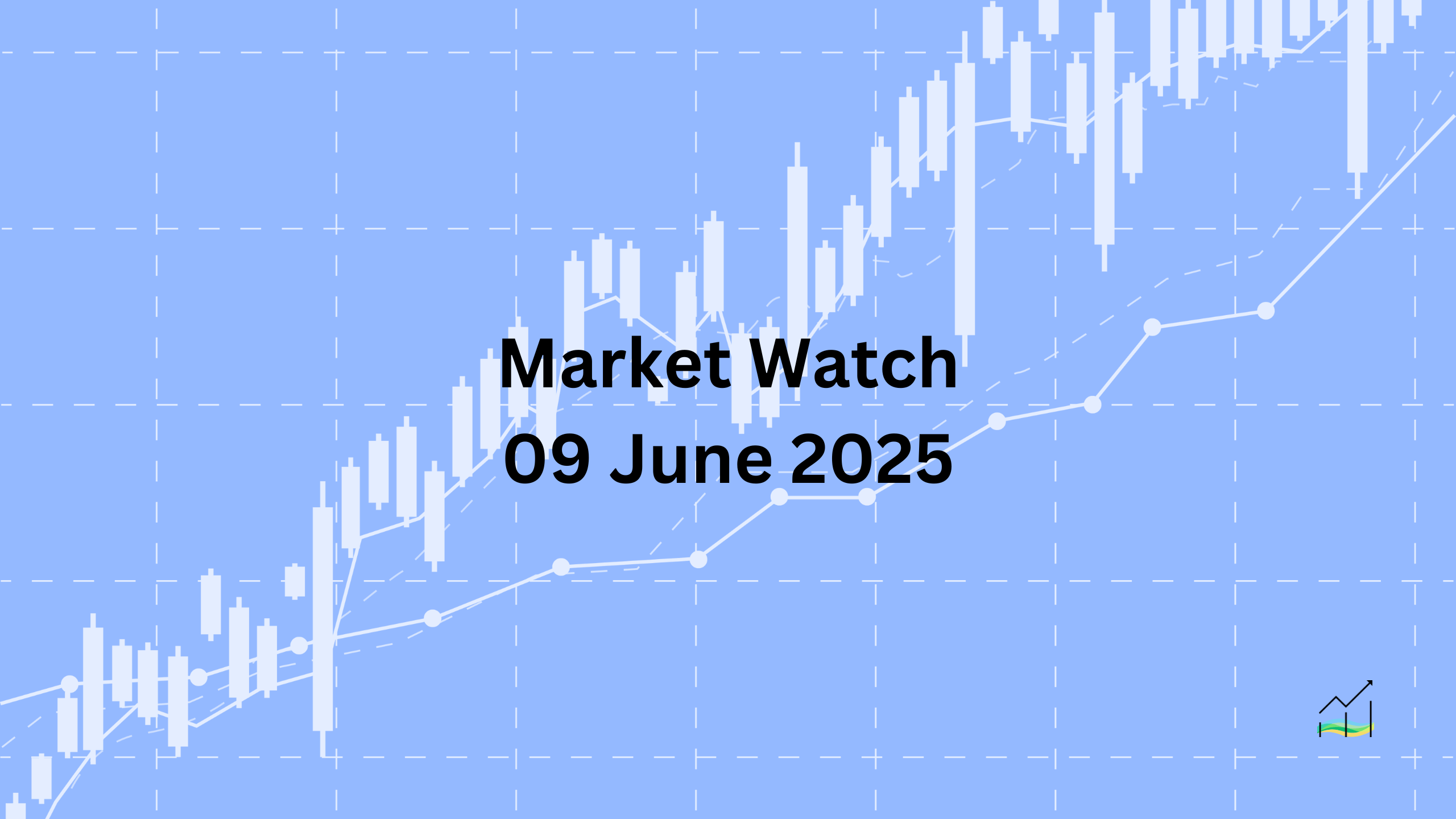09/06/2025 Market Watch

Dollar Retreats Amid Renewed US-China Dialogue
Key Takeaways:
- US dollar weakens despite stronger-than-expected US jobs report.
- China resumes rare earth exports; trade talks with US underway in London.
- Japan’s Q1 GDP revised from contraction to stagnation.
- Asian equities rally, European markets stall, US futures remain stable.
- Treasury yields ease slightly, gold consolidates, oil trades near recent highs.
The US dollar faced pressure early this week despite the upbeat US jobs report released last Friday, which alleviated recent concerns triggered by weaker private sector employment data and rising jobless claims. Asian and European market participants reversed the dollar’s gains achieved before the weekend, reflecting cautious optimism ahead of significant geopolitical discussions.
US-China trade negotiations resumed today in London amid easing tensions, notably marked by China lifting its temporary restrictions on rare earth exports to the US and Europe. This recent move highlighted China’s strategic dominance in the rare earth minerals sector, a clear reminder of mutual interdependence given the US leadership in semiconductor technology.
China's latest economic data presented a mixed picture, showing slower overall exports last month with a notable decline to the US, though it managed to achieve a larger overall trade surplus. Japan, meanwhile, saw a slight upward revision of its first-quarter GDP data. Instead of a contraction, the economy is now viewed as stagnant, primarily driven by improved consumer spending and inventory levels despite declining business investments.
Market performance across regions diverged. Asia-Pacific equities, buoyed by optimism, rallied, with Hong Kong leading gains exceeding 1%. Conversely, European equities halted a recent winning streak, with the Stoxx 600 turning downward, while US index futures showed minimal movements. Bond markets saw yields soften modestly in Europe and the US, easing some of the upward pressures experienced last week.
Commodity markets were mixed. Gold initially extended recent losses but found some stability, while oil continued trading near its two-month peak, signaling sustained investor confidence in energy markets amid ongoing geopolitical and economic uncertainties.
United States of America
Overview
The Dollar Index strengthened significantly heading into the weekend, supported by contrasting economic reports. A disappointing German industrial output figure juxtaposed with a stronger-than-expected US jobs report provided momentum, pushing the index near key retracement levels from its May peak. However, buying momentum hasn't persisted into the new week, with the index remaining contained within Friday's range and showing signs of potential weakness.
Domestic factors such as the unrest in Los Angeles, involving the National Guard and threats of Marines' deployment, have added uncertainty to the broader market sentiment, although the direct impact on capital markets remains unclear. Upcoming economic indicators, particularly Wednesday's Consumer Price Index (CPI), will be critical in determining the dollar’s direction, as inflation expectations remain elevated according to surveys, compared to market-based measures.
Investors' expectations for Federal Reserve policy adjustments shifted following the latest employment figures. Fed funds futures suggest that markets are increasingly uncertain whether the Fed will deliver two rate cuts this year, now projecting the next possible cut into the fourth quarter.
Economic Drivers
- Robust US jobs data contrasting sharply with disappointing European indicators, particularly from Germany.
- Elevated inflation expectations reflected in surveys compared to market-based indicators.
- Domestic social unrest raising uncertainty but with ambiguous market impacts.
- Federal Reserve policy uncertainty increasing due to shifting rate-cut expectations.
Data and Events
No major economic releases are scheduled today.
Price Action
- The Dollar Index currently consolidating within last Friday’s range (around 98.65–98.80), vulnerable to downside moves.
- Immediate support identified near last week's low (around 98.35), crucial for near-term direction.
Key Points:
- Dollar strength driven by divergent economic data from US and Europe.
- Market cautious ahead of significant CPI data.
- Fed rate-cut expectations increasingly uncertain.
- Domestic unrest causing unclear market influence.
- Technical consolidation suggests potential vulnerability ahead.
Canada
Overview
The US dollar bounced back from a yearly low against the Canadian dollar last Thursday, briefly exceeding the CAD1.3700 level going into the weekend. This recovery was primarily driven by stronger-than-expected US economic data overshadowing Canada’s mixed employment figures.
Despite Canada reporting a notable increase of nearly 58,000 full-time jobs, the strongest in five months, underlying indicators suggest weaknesses. Canada's unemployment rate climbed to a cyclical high of 7%, notably higher than 6.3% a year earlier. Additionally, aggregate hours worked dropped, signaling less overall economic productivity, while key sectors such as manufacturing and transportation reported job losses.
Entering the current week, the USD/CAD has once again faced selling pressure, trading close to the recent low point around CAD1.3660, indicating continued cautious sentiment toward the US dollar.
Economic Drivers
- Stronger-than-anticipated US economic data influencing exchange rate dynamics.
- Canadian employment figures masking deeper economic vulnerabilities.
- Rising unemployment rate in Canada, suggesting broader economic challenges.
- Declining productivity and sector-specific job losses in Canada's manufacturing and logistics.
Data and Events
No major economic releases are scheduled today.
Price Action
- USD/CAD currently trading near recent lows (~CAD1.3660), indicating potential vulnerability.
- Immediate resistance around CAD1.3700; support remains near yearly low (CAD1.3635).
Key Points:
- US dollar rebound driven by strong US economic reports.
- Canadian employment data superficially strong but underlying weaknesses present.
- Canada facing increased unemployment and sector-specific job reductions.
- USD/CAD remains heavy and vulnerable around recent lows.
China
Overview
The Chinese yuan is undergoing a consolidation phase against the US dollar. After approaching its yearly low around CNH7.1615 in late May, the yuan recently recovered, reaching close to CNH7.1940 before settling lower again, around CNH7.1825 today. This recent weakening aligns with a broadly softer market sentiment despite the People’s Bank of China (PBOC) adjusting the official daily midpoint slightly higher.
China's economic backdrop remains challenging, particularly as deflationary pressures persist. Producer prices saw their sharpest annual decline since July 2023, dropping by 3.3% in May. This highlights significant issues of excess production and investment in the economy. Concurrently, consumer prices also edged into negative territory, mainly driven by declining food prices, although the core inflation rate, which excludes food and energy, held steady at 0.6%.
May’s trade data provided additional insights into China's economic conditions. While exports to the United States decreased, China's overall exports still rose by 4.8%, albeit slower than the previous month. Imports, however, contracted further, resulting in a larger trade surplus of approximately $103.22 billion, up from $96.2 billion in April.
Economic Drivers
- Deflationary pressures, with significant declines in both producer and consumer prices.
- Continued overcapacity in production sectors, contributing to economic imbalance.
- Persistent challenges in consumer demand, particularly within the food sector.
- Large trade surplus despite slower growth in exports and declining imports.
Data and Events
- 09 June 2025: CPI.
- 09 June 2025: PPI.
- 09 June 2025: Trade Balance.
- 09 June 2025: New Loans.
Price Action
- The yuan currently trading near CNH7.1825, retreating from recent highs (~CNH7.1940).
- Immediate support remains around yearly low (~CNH7.1615), with resistance around CNH7.1940.
Key Points:
- Yuan consolidates amid softer market sentiment.
- Deflationary pressures deepen, especially in producer prices.
- China reports larger trade surplus despite slower export growth.
- Core inflation remains stable despite broader price weaknesses.
- Technical range suggests continued cautious trading environment.
Japan
Overview
The US dollar found solid support last week around the JPY142.40-60 region and surged briefly past the JPY145.00 mark following strong US employment figures that drove US bond yields higher. Closing above its 20-day moving average for the first time since mid-May, the greenback has, however, eased back today, trading around JPY144 during European market hours.
Japan released revised first-quarter GDP data, adjusting its earlier reported contraction to show the economy stagnated instead. This improvement was primarily driven by slight upward revisions in consumer spending and stronger inventory buildup, even though business investment was revised downward. Despite this, net exports continued to negatively impact growth significantly.
Additionally, Japan’s current account data for April confirmed a recurring seasonal pattern, as the surplus narrowed notably. This decline was primarily driven by the trade balance swinging back into deficit, underscoring persistent vulnerabilities in Japan’s export-led economic structure.
Economic Drivers
- Revised GDP data indicates economic stagnation, supported by improved consumer spending and inventories.
- Persistent trade deficit pressures Japan’s current account surplus.
- Negative contribution from net exports highlights external demand challenges.
- Rising GDP deflator underscores sustained inflationary pressures.
Data and Events
- 09 June 2025: Current Account.
- 09 June 2025: Final GDP.
- 09 June 2025: Economy Watchers Sentiment.
Price Action
- Dollar currently consolidating around JPY144, retreating from recent highs (~JPY145).
- Support remains near JPY143.45 (Friday’s low), with resistance around recent highs (~JPY145).
Key Points:
- Dollar supported by strong US economic data and rising yields.
- Japanese GDP data revised upward but economic stagnation remains.
- Japan’s trade balance returns to deficit, reducing current account surplus.
- Technical indicators suggest cautious trading around current levels.
United Kingdom
Overview
Sterling paused its recent advance at the close of last week, retreating slightly after touching a fresh three-year high near $1.3615. The US dollar's late-week recovery led sterling lower towards the $1.3500 level. Currently, the currency remains steady within Friday’s established trading range, positioning itself for a potential retest of the $1.3600 mark during North American trading hours.
The UK economic calendar begins quietly this week but intensifies with key releases due, notably the employment figures on Tuesday and GDP data for April set for Thursday. These reports will be closely watched by market participants to gauge the economic momentum in the UK.
From a monetary policy perspective, recent statements from Bank of England officials have effectively ruled out the possibility of an interest rate cut during the upcoming meeting next week. However, market pricing suggests a strong probability—nearly two-thirds—that the Bank might lower rates at its August meeting, with the first cut fully priced in by November.
Economic Drivers
- Anticipation surrounding employment and GDP data releases this week.
- Limited expectation of immediate rate cuts by the Bank of England.
- Market pricing indicates higher likelihood of a rate cut later in the year.
- Recent strengthening of the US dollar placing downward pressure on sterling.
Data and Events
No major economic releases are scheduled today.
Price Action
- Sterling trading within Friday's range (~$1.3510-$1.3585).
- Immediate resistance around recent high (~$1.3615); support at around $1.3500.
Key Points:
- Sterling consolidates after reaching a three-year high.
- Significant economic data (employment and GDP) due later in the week.
- Bank of England unlikely to cut rates next week, but market sees August or November rate cut likely.
- Price action remains stable but poised for potential upward tests near $1.3600.
© 2025 SKONE Enterprise (003319453-V). All rights reserved.
The content on this site is for informational purposes only and does not constitute financial advice.


